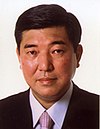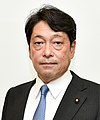Minister of Defense (Japan)
This article has multiple issues. Please help improve it or discuss these issues on the talk page. (Learn how and when to remove these messages)
|
| Minister of Defense | |
|---|---|
| 防衛大臣 | |
 Standard of the Minister of Defense | |
since 1 October 2024 | |
| Ministry of Defense | |
| Style | His Excellency |
| Member of | Cabinet National Security Council Defense Council |
| Reports to | The Prime Minister |
| Appointer | The Prime Minister subject to formal attestation by the Emperor |
| Precursor | Director General of the Defense Agency |
| Formation | 9 January 2007 |
| First holder | Fumio Kyuma |
| Deputy | State Minister of Defense |
| Salary | ¥20,916,000 |
The Minister of Defense (防衛大臣, Bōei Daijin), or Bōei-shō (防衛相), is a member of the Japanese cabinet and is the leader of the Japanese Ministry of Defense, the executive department of the Japanese Armed Forces. The minister of defense’s position of command and authority over the military is second only to that of the Prime Minister of Japan, who is the commander-in-chief.
The minister of defense is appointed by the Prime Minister and is a member of the National Security Council. The current Minister of Defense is Gen Nakatani, who took office on October 1, 2024.
History
[edit]On 26 December 2007, the Government of Japan made the decision to reform its Defense Agency to the Ministry of Defense in the expectation to have a far-reaching effect on Japan's future military development.[1] The defense policy that has been pursued by Japan is based on the "Basic Policy for National Defense", which was adopted by the Cabinet in May 1957.[2] Japan's main goal of national defense is the prevention of indirect as well as direct aggression from outside enemies.
The Japanese government reformed the Defense Agency to the Ministry of Defense with a ceremony that was attended by then Prime Minister Shinzō Abe and the then-new Minister of Defense Fumio Kyuma. The creation of the Ministry of Defense was in conjunction with Prime Minister Shinzō Abe's continued efforts to ensure a stronger image of the Japan Self-Defense Forces (JSDF). The bill in which to upgrade the Defense Agency to the Ministry of Defense was approved by the House of Representatives (lower house) in November 2006, and the House of Councillors (upper house) in mid-December 2006. Minister Kyuma personally attended a session in the House of Councillors and gave a speech after the bill was approved.[3]
In light of the Defense Agency being transformed into the Ministry of Defense, the JSDF was given the responsibilities of international operations, disaster relief and peacekeeping within the overseas locations.
On 11 September 2019, Taro Kono became the first high profile 'prime minister-ready' politician to head the Ministry of Defense. He has the strongest LDP factional backing of any defense minister thus far. His social media following is second only to Prime Minister Shinzo Abe. He's a leading candidate for post-Abe premiership. Kono previously held the prominent role of foreign minister.[4]
Chain of command
[edit]- 1. Prime Minister
- 2. Minister of Defense
- 3. Chief of Staff, Joint Staff
Structure
[edit]The Commander-in-Chief of the Japan Self-Defense Forces (JSDF), who does not formally constitute a uniformed military, is the Prime Minister. The Emperor of Japan is a constitutional monarch who does not have political or military authority over the JSDF; that authority rests with the Prime Minister. However, it is important to note that the Emperor formally appoints the Prime Minister to office. The Minister of Defense is responsible for the organization and formulating the national security policy. The budget request is drafted by the Ministry of Finance and making its own legislative proposals to the National Diet.
The Minister of Defense is advised on every concern related to the duties of the Japan Self-Defense Forces by the Chief of Staff, Joint Staff.
List of ministers of defense (2007–present)
[edit]| Minister of Defense | Term of office | Prime Minister | ||||||
|---|---|---|---|---|---|---|---|---|
| # | Portrait | Name | Took office | Left office | Time in office | |||
| 1 | 
|
Fumio Kyuma | January 9, 2007 | July 4, 2007 | 176 days | Shinzō Abe | ||
| 2 | 
|
Yuriko Koike | July 4, 2007 | August 27, 2007 | 54 days | |||
| 3 | 
|
Masahiko Kōmura | August 27, 2007 | September 26, 2007 | 30 days | |||
| 4 | 
|
Shigeru Ishiba | September 26, 2007 | August 2, 2008 | 311 days | Yasuo Fukuda | ||
| 5 | 
|
Yoshimasa Hayashi | August 2, 2008 | September 24, 2008 | 53 days | |||
| 6 | 
|
Yasukazu Hamada | September 24, 2008 | September 16, 2009 | 357 days | Taro Aso | ||
| 7 | 
|
Toshimi Kitazawa | September 16, 2009 | September 2, 2011 | 1 year, 351 days | Yukio Hatoyama | ||
| Naoto Kan | ||||||||
| 8 | 
|
Yasuo Ichikawa | September 2, 2011 | January 13, 2012 | 133 days | Yoshihiko Noda | ||
| 9 | 
|
Naoki Tanaka | January 13, 2012 | June 4, 2012 | 143 days | |||
| 10 | 
|
Satoshi Morimoto | June 4, 2012 | December 26, 2012 | 205 days | |||
| 11 | 
|
Itsunori Onodera | December 26, 2012 | September 3, 2014 | 1 year, 251 days | Shinzō Abe | ||
| 12 | 
|
Akinori Eto | September 3, 2014 | December 24, 2014 | 112 days | |||
| 13 | 
|
Gen Nakatani | December 24, 2014 | August 3, 2016 | 1 year, 223 days | |||
| 14 | 
|
Tomomi Inada | August 3, 2016 | July 28, 2017 | 359 days | |||
| – | 
|
Fumio Kishida (Acting) |
July 28, 2017 | August 3, 2017 | 6 days | |||
| 15 (11) |

|
Itsunori Onodera | August 3, 2017 | October 2, 2018 | 1 year, 60 days | |||
| 16 | 
|
Takeshi Iwaya | October 2, 2018 | September 11, 2019 | 344 days | |||
| 17 | 
|
Tarō Kōno | September 11, 2019 | September 16, 2020 | 1 year, 5 days | |||
| 18 | 
|
Nobuo Kishi | September 16, 2020 | August 10, 2022 | 1 year, 328 days | Yoshihide Suga | ||
| Fumio Kishida | ||||||||
| 19 (6) |

|
Yasukazu Hamada | August 10, 2022 | September 13, 2023 | 1 year, 34 days | |||
| 20 | 
|
Minoru Kihara | September 13, 2023 | October 1, 2024 | 1 year, 18 days | |||
| 21 (13) |

|
Gen Nakatani | October 1, 2024 | Incumbent | 39 days | Shigeru Ishiba | ||
Allied occupation of Japan
[edit]Following the end of World War II, the Armed Forces of the Empire of Japan were disbanded and US forces took control. From 1950 to 1952, the National Police Reserve led by Minister of State Takeo Ōhashi was formed. It was renamed as the National Safety Force in 1952. In 1952, the Coastal Safety Force, the waterborne counterpart of the National Police Reserve, was founded and led by the Commissioner of the Coastal Safety Force (保安庁長官) Tokutarō Kimura.
Directors general of the Defense Agency
[edit]These are the directors general of the Defense Agency. It is the predecessor of the Ministry of Defense which was established on 9 January 2007.
- Tokutarō Kimura 1954
- Seiichi Ōmura 1954-1955
- Arata Sugihara 1955
- Shigemasa Sunada 1955
- Funada Naka 1955-1956
- Tanzan Ishibashi 1956-1957
- Nobusuke Kishi 1957
- Akira Kodaki 1957
- Juichi Tsushima 1957-1958
- Gisen Satō 1958-1959
- Shigejirō Inō 1959
- Munenori Akagi 1959-1960
- Masumi Esaki 1960
- Naomi Nishimura 1960
- Sensuke Fujieda 1961-1962
- Kenjirō Shiga 1962-1963
- Fukuda Tokuyasu 1963-1964
- Jun'ya Koizumi 1964-1965
- Raizo Matsuno 1965-1966
- Eikichi Kanbayashiyama 1966
- Kaneshichi Masuda 1966-1968
- Kiichi Arita 1968-1970
- Yasuhiro Nakasone 1970-1971
- Keiichi Masuhara 1971
- Naomi Nishimura 1971
- Ezaki Masumi 1971-1972
- Keiichi Masuhara 1972-1973
- Yamanaka Yasunori 1973-1974
- Sōsuke Uno 1974
- Michita Sakata 1974-1976
- Asao Mihara 1976-1977
- Shin Kanemaru 1977-1978
- Ganri Yamashita 1978-1979
- Enji Kubota 1979-1980
- Yoshizo Hosoda 1980
- Koji Omura 1980-1981
- Soichiro Ito 1981-1982
- Kazuho Tanigawa 1982-1983
- Kurihara Yoshiyuki 1983-1984
- Koichi Kato 1984-1986
- Kurihara Yoshiyuki 1986-1987
- Riki Kawara 1987-1988
- Kichirō Tazawa 1988-1989
- Taku Yamasaki 1989
- Jūrō Matsumoto 1989-1990
- Yozo Ishikawa 1990
- Yukihiko Ikeda 1990-1991
- Sohei Miyashita 1991-1992
- Toshio Nakayama 1992-1993
- Nakanishi Keisuke 1993
- Kazuo Aichi 1993-1994
- Atsushi Kanda 1994
- Tokuichiro Tamazawa 1994-1995
- Seishirō Etō 1995-1996
- Hideo Usui 1996
- Fumio Kyūma 1996-1998
- Fukushiro Nukaga 1998
- Hosei Norota 1998-1999
- Riki Kawara 1999-2000
- Kazuo Torashima 2000
- Toshitsugu Saito 2000-2001
- Gen Nakatani 2001-2002
- Shigeru Ishiba 2002-2004
- Yoshinori Ohno 2004-2005
- Fukushiro Nukaga 2005-2006
- Fumio Kyūma 2006-2007
Ministers with military experience
[edit]Although Article 68 of the Constitution states that all members of the Cabinet must be civilians, former military persons may be appointed Minister of Defense.
- Raizo Matsuno - served in the Imperial Japanese Navy during World War II and rose to rank of Lieutenant commander
- Yasuhiro Nakasone - served in the Imperial Japanese Navy during World War II and rose to rank of Lieutenant commander and worked as Paymaster
- Sōsuke Uno - served in the Imperial Japanese Army during World War II and rose to rank of Second Lieutenant
- Soichiro Ito - served in the Imperial Japanese Army during World War II and rose to rank of Second Lieutenant
- Shin Kanemaru - served briefly in the Kwantung Army as Sergeant in 1937-1938 and was discharged due to illness
- Satoshi Morimoto - served in Japan Air Self-Defense Force and rose to rank as Major
- Gen Nakatani - served in Japan Ground Self-Defense Force as platoon leader and instructor with rank of Lieutenant
See also
[edit]Previous positions that covered the role of the Minister of Defense:
- Ministers of the Army of Japan - created in 1885 (Ministry existed since 1872) to administer the Imperial Japanese Army and abolished in 1945
- Ministers of the Navy of Japan - created in 1885 (Ministry existed since 1872) to administer the Imperial Japanese Navy and abolished in 1945
- There was no Ministry or Minister of Air Force rather the navy and army had their own separate bureaux:
- Imperial Japanese Naval Aviation Bureau was led by a Commander
- Vice Admiral Eikichi Katagiri served in 1941-1945
- Imperial Japanese Army Air Service
- Imperial Japanese Naval Aviation Bureau was led by a Commander
- Minister of War - created in 683 as Hyōseikan to administer military affairs, renamed as Hyōbu-shō in 702 and lasted to 1872; Ministers were either son or relative of the Emperor
References
[edit]- ^ "Japan creates defense ministry". BBC News. December 15, 2006.
- ^ "Archived copy" (PDF). Archived from the original (PDF) on November 29, 2020. Retrieved March 26, 2020.
{{cite web}}: CS1 maint: archived copy as title (link) - ^ "SPECIAL FEATURE | JDF - Japan Defense Focus (No.4) | Japan Ministry of Defense". Archived from the original on February 17, 2020. Retrieved March 26, 2020.
- ^ Michael Macarthur Bosack (October 17, 2019). "Taro Kono: A different kind of defense minister". The Japan Times. Archived from the original on December 10, 2019. Retrieved January 9, 2020.
- "Library of Congress Country Studies", JAPAN, The Defense Agency. [1]. Retrieved 18 July 2010.

